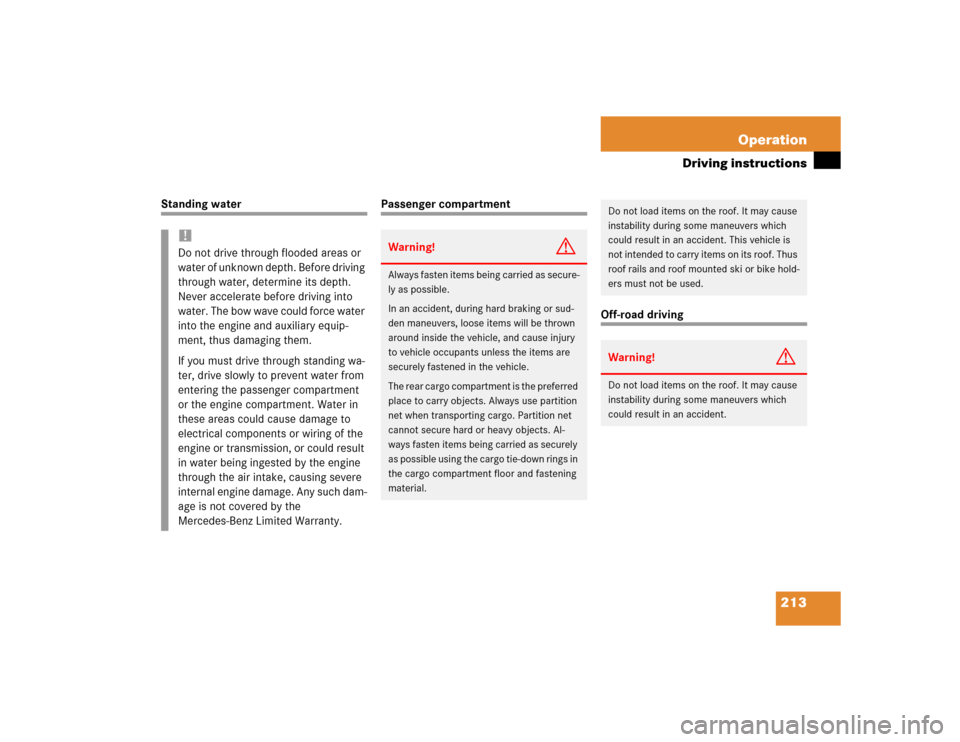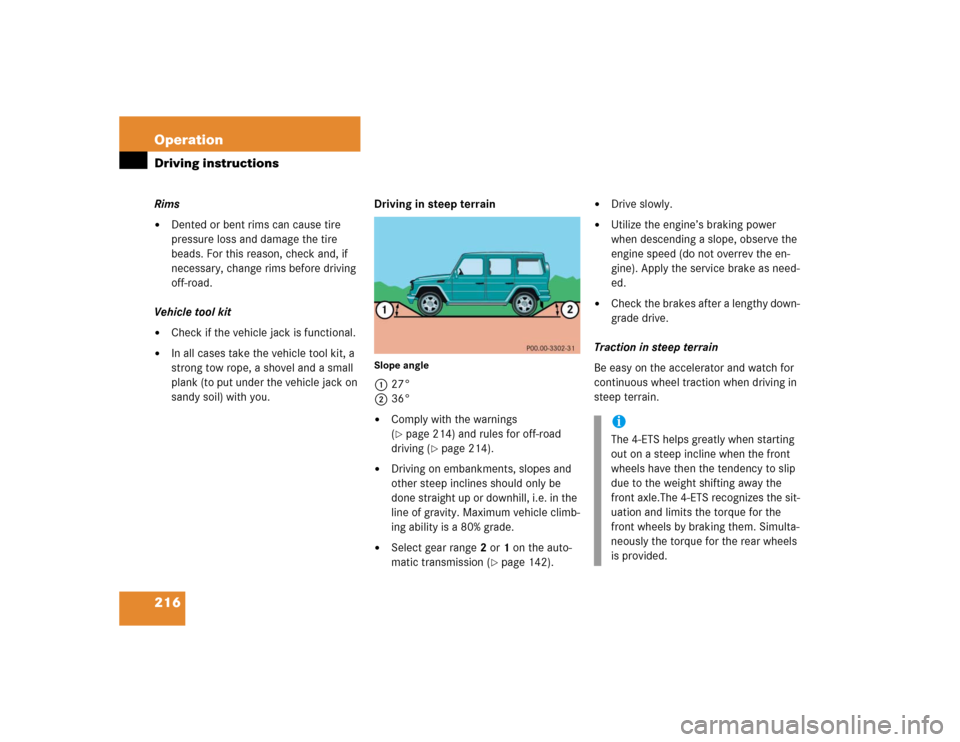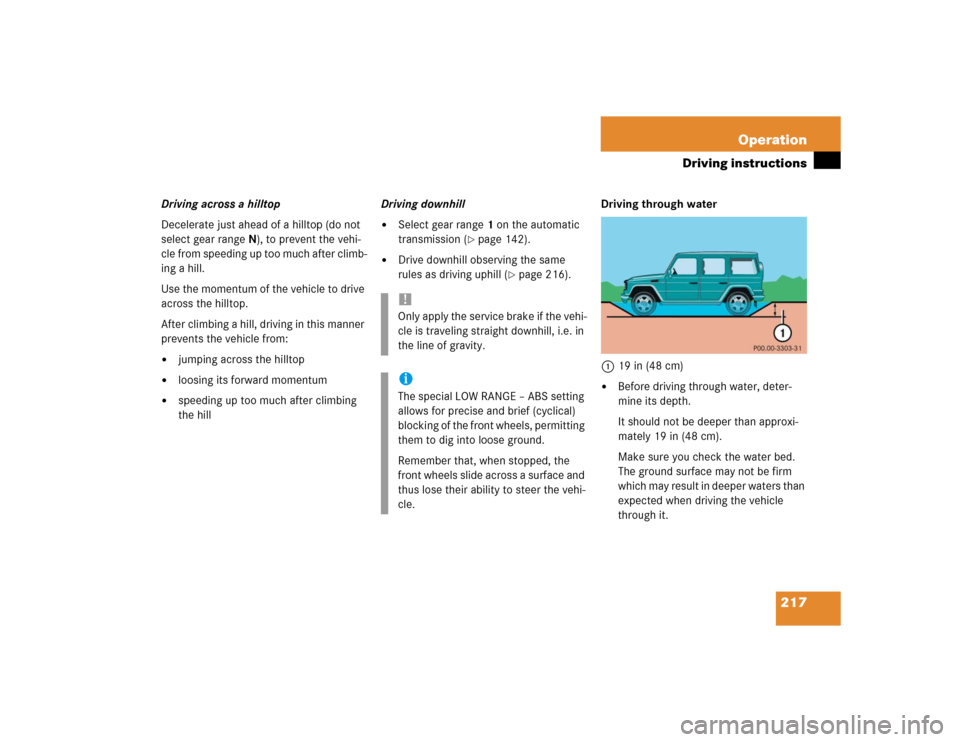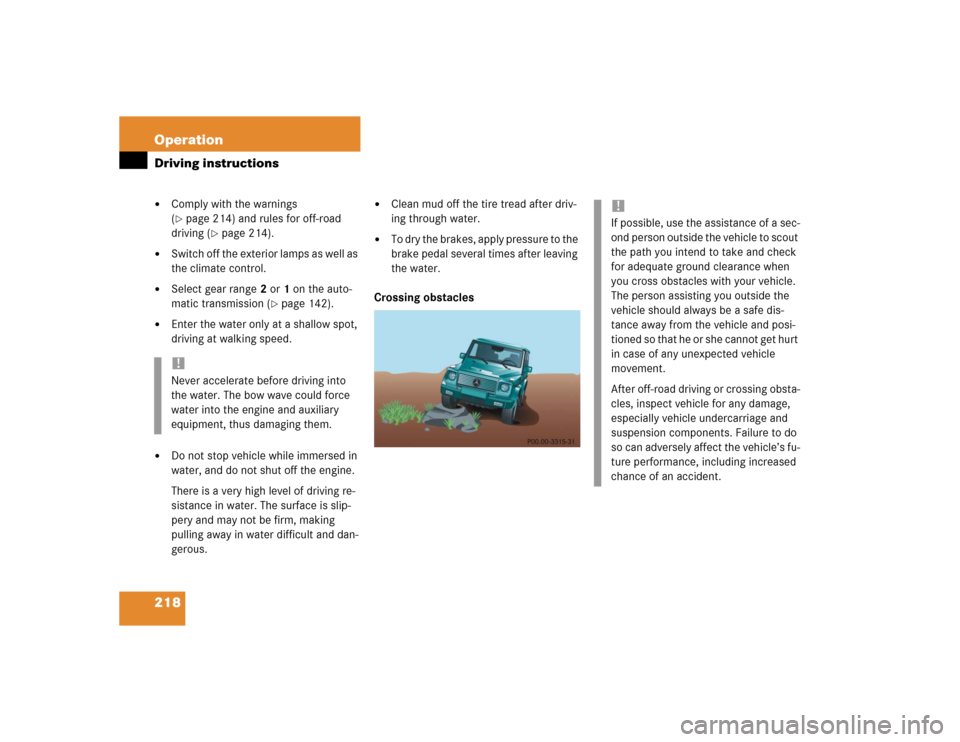Page 213 of 376

213 Operation
Driving instructions
Standing water
Passenger compartment
Off-road driving
!Do not drive through flooded areas or
water of unknown depth. Before driving
through water, determine its depth.
Never accelerate before driving into
water. The bow wave could force water
into the engine and auxiliary equip-
ment, thus damaging them.
If you must drive through standing wa-
ter, drive slowly to prevent water from
entering the passenger compartment
or the engine compartment. Water in
these areas could cause damage to
electrical components or wiring of the
engine or transmission, or could result
in water being ingested by the engine
through the air intake, causing severe
internal engine damage. Any such dam-
age is not covered by the
Mercedes-Benz Limited Warranty.
Warning!
G
Always fasten items being carried as secure-
ly as possible.
In an accident, during hard braking or sud-
den maneuvers, loose items will be thrown
around inside the vehicle, and cause injury
to vehicle occupants unless the items are
securely fastened in the vehicle.
The rear cargo compartment is the preferred
place to carry objects. Always use partition
net when transporting cargo. Partition net
cannot secure hard or heavy objects. Al-
ways fasten items being carried as securely
as possible using the cargo tie-down rings in
the cargo compartment floor and fastening
material.
Do not load items on the roof. It may cause
instability during some maneuvers which
could result in an accident. This vehicle is
not intended to carry items on its roof. Thus
roof rails and roof mounted ski or bike hold-
ers must not be used.Warning!
G
Do not load items on the roof. It may cause
instability during some maneuvers which
could result in an accident.
Page 216 of 376

216 OperationDriving instructionsRims�
Dented or bent rims can cause tire
pressure loss and damage the tire
beads. For this reason, check and, if
necessary, change rims before driving
off-road.
Vehicle tool kit
�
Check if the vehicle jack is functional.
�
In all cases take the vehicle tool kit, a
strong tow rope, a shovel and a small
plank (to put under the vehicle jack on
sandy soil) with you.Driving in steep terrain
Slope angle127°
236°�
Comply with the warnings
(�page 214) and rules for off-road
driving (
�page 214).
�
Driving on embankments, slopes and
other steep inclines should only be
done straight up or downhill, i.e. in the
line of gravity. Maximum vehicle climb-
ing ability is a 80% grade.
�
Select gear range2 or1 on the auto-
matic transmission (
�page 142).
�
Drive slowly.
�
Utilize the engine’s braking power
when descending a slope, observe the
engine speed (do not overrev the en-
gine). Apply the service brake as need-
ed.
�
Check the brakes after a lengthy down-
grade drive.
Traction in steep terrain
Be easy on the accelerator and watch for
continuous wheel traction when driving in
steep terrain.iThe 4-ETS helps greatly when starting
out on a steep incline when the front
wheels have then the tendency to slip
due to the weight shifting away the
front axle.The 4-ETS recognizes the sit-
uation and limits the torque for the
front wheels by braking them. Simulta-
neously the torque for the rear wheels
is provided.
Page 217 of 376

217 Operation
Driving instructions
Driving across a hilltop
Decelerate just ahead of a hilltop (do not
select gear rangeN), to prevent the vehi-
cle from speeding up too much after climb-
ing a hill.
Use the momentum of the vehicle to drive
across the hilltop.
After climbing a hill, driving in this manner
prevents the vehicle from:�
jumping across the hilltop
�
loosing its forward momentum
�
speeding up too much after climbing
the hillDriving downhill
�
Select gear range1 on the automatic
transmission (
�page 142).
�
Drive downhill observing the same
rules as driving uphill (
�page 216).Driving through water
119 in (48 cm)
�
Before driving through water, deter-
mine its depth.
It should not be deeper than approxi-
mately 19 in (48 cm).
Make sure you check the water bed.
The ground surface may not be firm
which may result in deeper waters than
expected when driving the vehicle
through it.
!Only apply the service brake if the vehi-
cle is traveling straight downhill, i.e. in
the line of gravity.iThe special LOW RANGE – ABS setting
allows for precise and brief (cyclical)
blocking of the front wheels, permitting
them to dig into loose ground.
Remember that, when stopped, the
front wheels slide across a surface and
thus lose their ability to steer the vehi-
cle.
Page 218 of 376

218 OperationDriving instructions�
Comply with the warnings
(�page 214) and rules for off-road
driving (
�page 214).
�
Switch off the exterior lamps as well as
the climate control.
�
Select gear range2 or1 on the auto-
matic transmission (
�page 142).
�
Enter the water only at a shallow spot,
driving at walking speed.
�
Do not stop vehicle while immersed in
water, and do not shut off the engine.
There is a very high level of driving re-
sistance in water. The surface is slip-
pery and may not be firm, making
pulling away in water difficult and dan-
gerous.
�
Clean mud off the tire tread after driv-
ing through water.
�
To dry the brakes, apply pressure to the
brake pedal several times after leaving
the water.
Crossing obstacles
!Never accelerate before driving into
the water. The bow wave could force
water into the engine and auxiliary
equipment, thus damaging them.
!If possible, use the assistance of a sec-
ond person outside the vehicle to scout
the path you intend to take and check
for adequate ground clearance when
you cross obstacles with your vehicle.
The person assisting you outside the
vehicle should always be a safe dis-
tance away from the vehicle and posi-
tioned so that he or she cannot get hurt
in case of any unexpected vehicle
movement.
After off-road driving or crossing obsta-
cles, inspect vehicle for any damage,
especially vehicle undercarriage and
suspension components. Failure to do
so can adversely affect the vehicle’s fu-
ture performance, including increased
chance of an accident.
Page 219 of 376

219 Operation
Driving instructions
�
Check the vehicle clearance before
crossing obstacles.
�
Comply with the warnings
(�page 214) and rules for off-road
driving (
�page 214).
�
Select gear range1 on the automatic
transmission (
�page 142).
�
Cross obstacles (e.g. tree stumps or
big rocks) very slowly by aiming one of
the front wheels at the center of the ob-
stacle, and repeat same with the rear
wheel.Ruts
�
Check the vehicle clearance before
driving in ruts.
�
Comply with the warnings
(�page 214) and rules for off-road
driving (
�page 214).
�
Select gear range1 on the automatic
transmission (
�page 142).
�
Drive slowly next to the ruts rather than
through them if at all possible.
!Special attention is needed when you
cross obstacles on a steep incline.
The vehicle could slide sideways as a
result of its possible slanted position
which in turn may result in the vehicle
tipping or rolling over.
!A number of off-road tracks or other by-
roads have deep ruts. If the vehicle
does not have enough ground clear-
ance:�
it could be damaged
�
the underside of the vehicle may
come down on a surface and re-
main stuck
After off-road driving or crossing obsta-
cles, inspect vehicle for any damage,
especially vehicle undercarriage and
suspension components. Failure to do
so can adversely affect the vehicle’s fu-
ture performance, including increased
chance of an accident.
Page 232 of 376

232 OperationEngine compartment1Oil dipstick
2Oil filler cap�
Unscrew oil filler cap2 from filler
neck.
�
Add engine oil as required. Be careful
not to overfill with oil.
Be careful not to spill any oil when adding.
Avoid environmental damage caused by oil
entering the ground or water.
�
Screw oil filler cap2 back on filler
neck.
For more information on engine oil, see the
“Technical data” section (
�page 333) and
(
�page 334).
Transmission fluid level
The transmission fluid level does not need
to be checked. The transmission has a per-
manent supply of automatic transmission
fluid.
If you notice transmission fluid loss or gear
shifting malfunctions, have an authorized
Mercedes-Benz Light Truck Center check
the automatic transmission.Coolant level
The engine coolant is a mixture of water
and anticorrosion/antifreeze.
When checking the coolant level, �
the vehicle must be parked on level
ground.
�
the engine must be cool. The coolant
level should reach the COLD LEVEL
mark in the reservoir.
!Excess oil must be siphoned or drained
off. It could cause damage to the
engine and catalytic converter not
covered by the Mercedes-Benz Limited
Warranty.
Page 280 of 376
280 Practical hintsWhat to do if …Display symbol
Display message
Possible cause
Possible solution
<
SEAT BELT SYSTEM
DRIVE TO WORKSHOP!
The seat belt system is malfunctioning.
�
Visit an authorized Mercedes-Benz
Light Truck Center as soon as possi-
ble.
DRIVER’S SEAT BELT
FASTEN SEAT BELT!
The display reminds you and your passen-
gers to fasten seat belts.
�
Fasten the seat belts.
FR. PASS. SEAT BELT
FASTEN SEAT BELT!
The display reminds you and your passen-
gers to fasten seat belts.
�
Fasten the seat belts.
§
TC IN NEUTRAL
No gear has been selected in the transfer
case, it is in NEUTRAL.
�
Engage transfer case to gear position
HIGH or LOW (
�page 145).
Warning!
G
If the transfer case is in NEUTRAL, the
Pposition of transmission will not hold vehi-
cle. The parking brake must be applied to
hold vehicle in place.
Page 290 of 376
290 Practical hintsUnlocking/locking in an emergencyFuel filler flap
The emergency release is in the cargo
compartment behind the rear panel trim.
1Edge protection
2Rear panel trim�
Open the tailgate.
�
Remove edge protection1 from the
door pillar.
�
Remove rear panel trim2.3Release strap
�
Pull strap 3 upwards.
The fuel filler flap is unlocked and can
be opened. Manually unlocking the transmission
gear selector lever
In the case of power failure the transmis-
sion gear selector lever can be manually
unlocked, e.g. to tow the vehicle.
1Pin